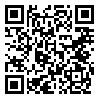1. Hakak SM, Kazemi SH, Kakavand A. The association between childhood traumas and dissociative experiences with Internet addiction in students of international university of Imam Khomeiny. Journal of Psychological Studies. 2019;15(1):23–40. [Persian] [
Article]
2. Seki T, Hamazaki K, Natori T, Inadera H. Relationship between Internet addiction and depression among Japanese university students. J Affect Disord. 2019;256:668–72. [
DOI]
3. Lei H, Cheong CM, Li S, Lu M. The relationship between coping style and Internet addiction among mainland Chinese students: a meta-analysis. Psychiatry Res. 2018;270:831–41. [
DOI]
4. Khanjani M, Ghanbari F, Naeimi E. Investigating the relationship between family function, attachment style and parenting styles with Internet addiction in adolescents. Culture of Counseling Quarterly and Psychotherapy. 2019;10(37):121–42. [Persian] [
Article]
5. Błachnio A, Przepiorka A, Benvenuti M, Mazzoni E, Seidman G. Relations between Facebook intrusion, Internet addiction, life satisfaction, and self-esteem: a study in Italy and the USA. Int J Ment Health Addiction. 2019;17(4):793–805. [
DOI]
6. Isaacson JI, Jordaan Y, Van Heerden G. The relationship between individual-level culture and consumer decision-making styles through consumer involvement. Journal of Retailing and Consumer Services. 2018;41:112–20. [
DOI]
7. Masoumian Miandoab P. Individual-level cultural values: decision making styles among individualist and collectivist customers (case study: customers of automobile radial tire). Journal of Business Management. 2020;12(1):161–82. [Persian] [
Article]
8. Arias-De La Torre J, Fernández-Villa T, Molina AJ, Amezcua-Prieto C, Mateos R, Cancela JM, et al. Drug use, family support and related factors in university students. A cross-sectional study based on the uniHcos Project data. Gac Sanit. 2019;33(2):141–7. [
DOI]
9. Holloway K, Bennett T. Characteristics and correlates of drug use and misuse among university students in Wales: a survey of seven universities. Addiction Research & Theory. 2018;26(1):11–9. [
DOI]
10. Baiocco R, Laghi F, D'Alessio M. Decision-making style among adolescents: relationship with sensation seeking and locus of control. J Adolesc. 2009 Aug;32(4):963-76. [
DOI]
11. Gvion Y, Levi-Belz Y, Hadlaczky G, Apter A. On the role of impulsivity and decision-making in suicidal behavior. World J Psychiatry. 2015;5(3):255–9. [
DOI]
12. La Course A, Listwan SJ, Reid S, Hartman JL. Recidivism and reentry: the role of individual coping styles. Crime & Delinquency. 2019;65(1):46–68. [
DOI]
13. Alaghband L, Sharifi H P, Farzad V, Sghayousefi A. Predicting emotional divorce based on emotional literacy, coping styles, quality of life, resilience mediation. Journal of Psychological Science. 2020;19(90):733–43. [Persian] [
Article]
14. Chen C. The role of resilience and coping styles in subjective well-being among Chinese university students. Asia-Pacific Edu Res. 2016;25(3):377–87. [
DOI]
15. Lazarus RS, Folkman S. Stress, appraisal, and coping. First edition. New York: Springer; 1984.
16. Lee JH, Seo M, Lee M, Park SY, Lee JH, Lee SM. Profiles of coping strategies in resilient adolescents. Psychol Rep. 2017;120(1):49–69. [
DOI]
17. Alzoubi FA, Al-Smadi AM, Gougazeh YM. Coping strategies used by syrian refugees in Jordan. Clin Nurs Res. 2019;28(4):396–421. [
DOI]
18. Baumstarck K, Chinot O, Tabouret E, Farina P, Barrié M, Campello C, et al. Coping strategies and quality of life: a longitudinal study of high-grade glioma patient-caregiver dyads. Health Qual Life Outcomes. 2018;16(1):157. [
DOI]
19. Loehlin JC. Latent Variable Models an introduction to factor, path, and structural equation analysis. 4th edition. NJ: Lawrence Erlbaum Associates; 2004.
20. Young K. Psycholgy of Computer use: addictive use of the Internet: a case that breaks the stereotype. Psychol Rep. 1996;79(3):899–902. [
DOI]
21. Young KS. Internet addiction: the emergence of a new clinical disorder. CyberPsychology & Behavior. 1998;1(3):237–44. [
DOI]
22. Alavi SS, Jannatifard F, Islami , Rezapour H. Determining the validity and reliability of the Internet Addiction Disorder Diagnostic Questionnaire in student users. Zahedan Journal of Research in Medical Sciences. 2011;13(7):24-38. [Persian]
23. Folkman S, Lazarus RS. If it changes it must be a process: study of emotion and coping during three stages of a college examination. Journal of Personality and Social Psychology. 1985;48:150-70 . [
DOI]
24. Kiyani AR, Fathi D, Honarmand P, Abdi S, Staji R. The relationship between attachment styles, social support and coping styles with psychological resilience in groups with grief experience: path analysis. Culture of Counseling Quarterly and Psychotherapy. 2020;11(41):157–80. [Persian] [
Article]
25. Scott SG, Bruce RA. Decision-making style: the development and assessment of a new measure. Educ Psychol Meas. 1995;55(5):818–31. [
DOI]
26. Becker JM, Klein K, Wetzels M. Hierarchical latent variable models in PLS-SEM: guidelines for using reflective-formative type models. Long Range Planning. 2012;45(5–6):359–94. [
DOI]
27. Hosseini M, Ebrahimi F, Tabatabaei SS. Structural analysis the effect of decision making styles on students' addiction preparedness by mediating cognitive emotion regulation. Etiadpajohi. 2019;13(52):235–58. [Persian] [
Article]

 ، اسحق رحیمیان*2
، اسحق رحیمیان*2 
 ، فائزه جهان3
، فائزه جهان3 




